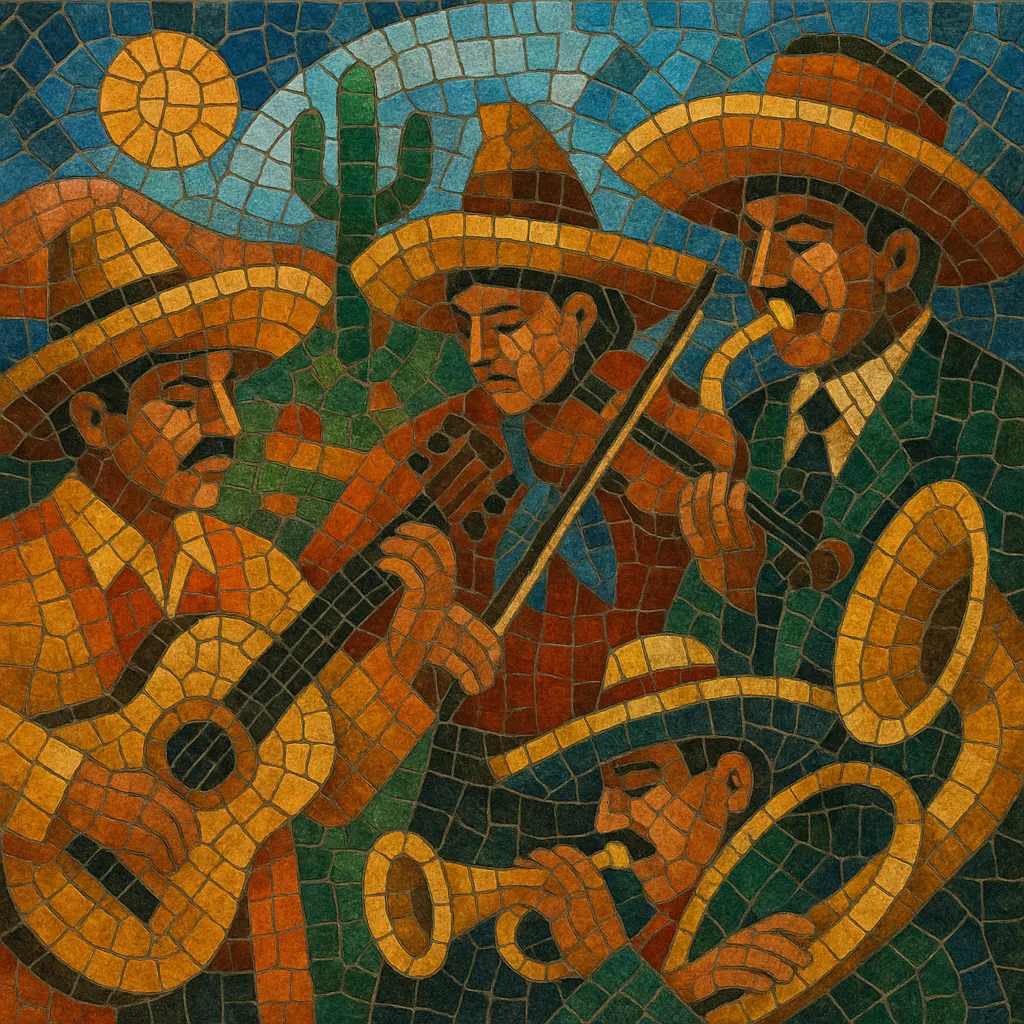Música mexicana is an umbrella term that encompasses Mexico’s traditional and popular vernacular styles, including mariachi, ranchera, norteño, banda, corridos, and various regional son traditions (such as son jarocho, son huasteco, and son calentano).
It is characterized by expressive vocals, melodic ornamentation, and storytelling lyrics, often accompanied by ensembles that combine strings, brass, and/or accordion. Rhythmic feels commonly draw from European dances like polka, waltz, and mazurka, alongside indigenous and Afro-Mexican rhythmic sensibilities and the sesquialtera (the interplay between 3/4 and 6/8 heard in music such as huapango).
The style ranges from intimate trios to full mariachi and banda orchestras, with themes spanning romance, nostalgia, identity, migration, rural life, and heroic or news-like narratives (in corridos).
Música mexicana took shape in the 1800s as regional string and brass traditions absorbed European social-dance rhythms (polka, waltz, mazurka) brought by immigrants and military bands. These influences intermixed with indigenous and Afro-Mexican practices, laying the groundwork for mariachi in Jalisco and diverse “son” families across the country. Early song forms emphasized storytelling, dance, and community ritual.
During and after the Mexican Revolution, corridos spread news and heroic narratives, while mariachi and ranchera songs crystallized as symbols of national identity. Radio, recordings, and the Golden Age of Mexican cinema (1930s–1950s) propelled iconic voices and the charro image, turning música mexicana into a cultural emblem at home and abroad.
Border regions nurtured accordion-led norteño, influenced by Central European polkas and waltzes, while Sinaloa developed powerful brass bandas. Bolero-romántico aesthetics and huapango’s sesquialtera coloration enriched harmonic and rhythmic palettes. Parallel movements such as grupera, and cross-border styles like Tex-Mex and Tejano, modernized instrumentation and studio production while keeping Mexican melodic and lyrical sensibilities.
Banda-pop fusions, sierreño trios, and contemporary corridos revitalized the tradition, and streaming amplified new hybrid forms (corrido tumbado, electro corridos, corridos bélicos) that weave trap and pop production with Mexican songcraft. International collaborations and touring have elevated música mexicana from a regional marker to a global mainstream presence while preserving its core narrative, vocal, and ensemble identities.
Decide on a sub-style and instrumentation. For mariachi, use violins, trumpets, vihuela, guitar, and guitarrón. For norteño or sierreño, center the accordion or requinto with bajo sexto and bass. For banda, write for full brass and woodwind choir with tuba-driven bass lines and percussion.
Pick a meter associated with the feel: 2/4 polka and 3/4 waltz are staples, while huapango alternates or overlays 6/8 and 3/4 (sesquialtera). Keep tempos danceable (roughly 90–140 BPM for polka/waltz feels), and ensure the bass (guitarrón or tuba) locks in with strummed strings or snare-driven polka patterns.
Use diatonic harmony with strong I–IV–V movement, secondary dominants, and occasional borrowed chords. Verses and refrains often follow strophic song structures; corridos favor narrative verses with a clear arc. Modulations can heighten emotion before a final chorus, and parallel thirds/sixths in the melody help achieve the signature duet and ensemble sonority.
Write singable, emotive melodies that allow for gritos (exclamatory shouts), portamento, and decorative turns. Provide instrumental interludes—trumpet/violin countermelodies in mariachi, accordion hooks in norteño, or unison riffs for banda—that restate or answer the vocal line.
Craft lyrics about love, longing, pride, place, family, work, and heroism. Corridos should narrate characters and events with concrete details, while rancheras and boleros emphasize poetic imagery, tenderness, and catharsis. Keep language direct and memorable, favoring chorus lines that invite audience singalongs.
If fusing with contemporary styles, layer subtle 808s, trap hats, or pop pads beneath traditional instruments. Preserve the acoustic attack and dynamics, keep vocals upfront and clear, and use call‑and‑response between lead voice and ensemble to maintain authenticity.


